Nestle's Business Strategy and Environment
VerifiedAdded on 2020/10/05
|19
|5139
|400
AI Summary
The assignment provided is a detailed analysis of Nestle's business strategy and environment. It begins with an introduction to the company, highlighting its history, products, and market presence. The next section provides a SWOT analysis of Nestle, identifying its strengths, weaknesses, opportunities, and threats in the competitive food industry. This is followed by a discussion on the company's environmental impact and strategies for sustainability, including its use of natural resources, waste management, and community development initiatives. Finally, the assignment references several academic sources that provide further insights into Nestle's business model generation and sustainable practices.
Contribute Materials
Your contribution can guide someone’s learning journey. Share your
documents today.
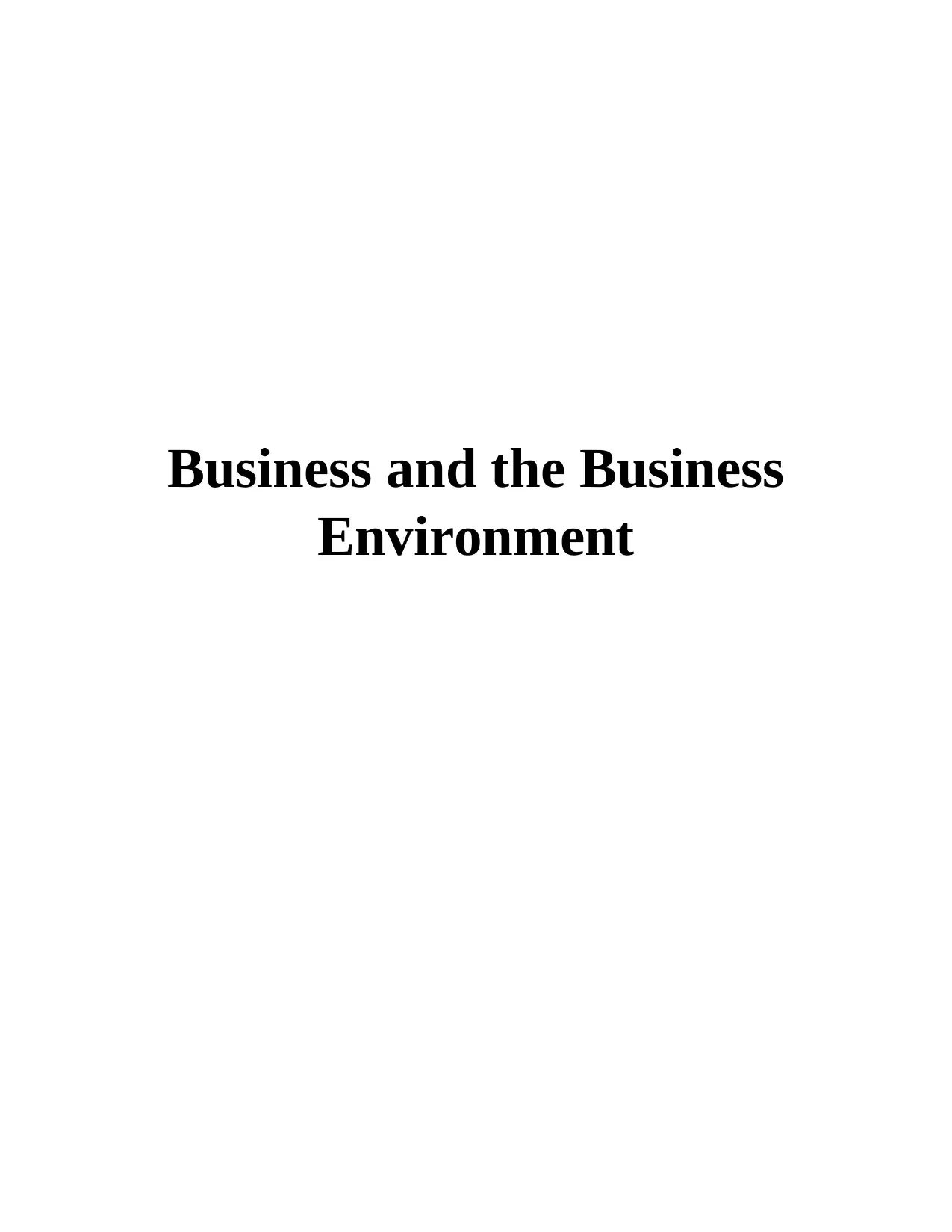
Business and the Business
Environment
Environment
Secure Best Marks with AI Grader
Need help grading? Try our AI Grader for instant feedback on your assignments.
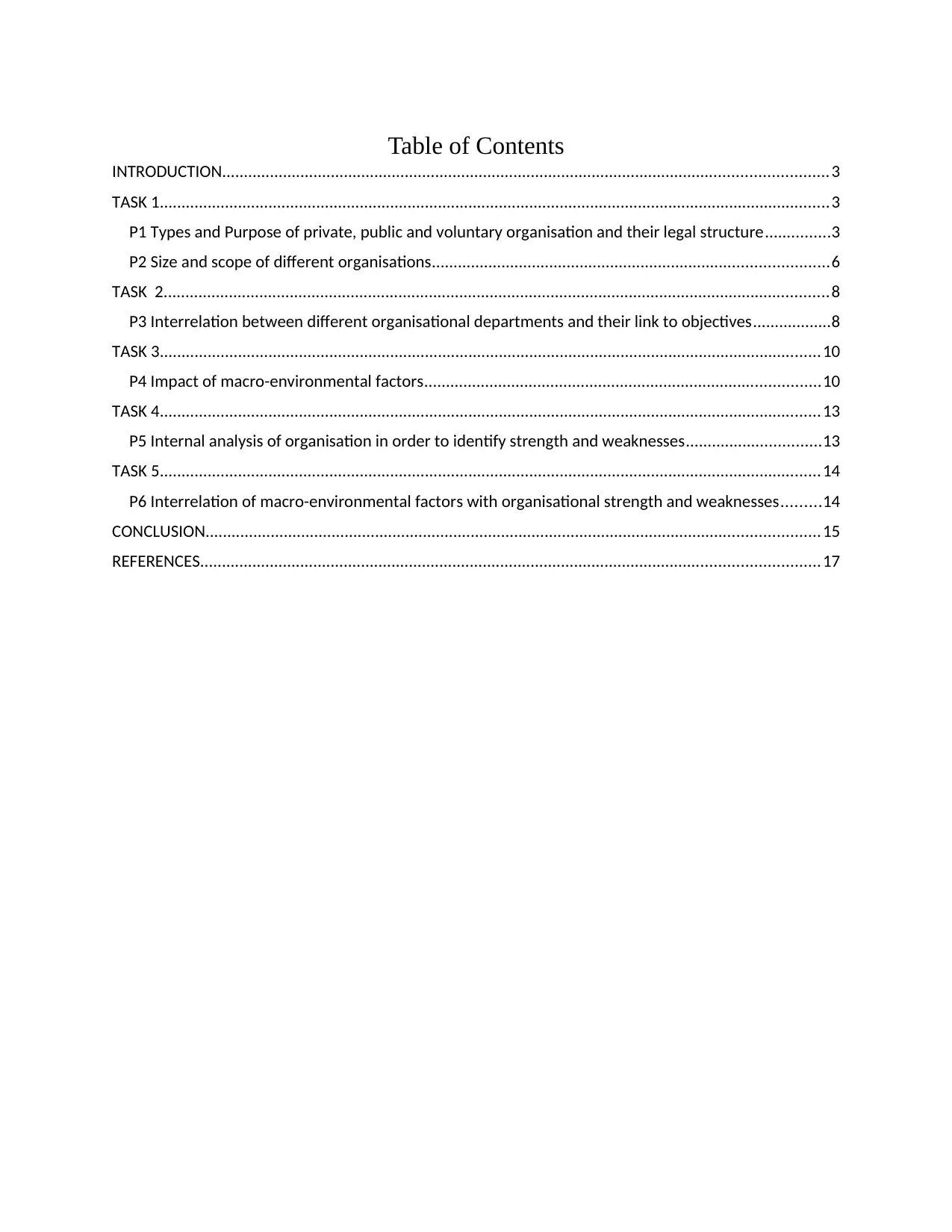
Table of Contents
INTRODUCTION...........................................................................................................................................3
TASK 1..........................................................................................................................................................3
P1 Types and Purpose of private, public and voluntary organisation and their legal structure...............3
P2 Size and scope of different organisations...........................................................................................6
TASK 2.........................................................................................................................................................8
P3 Interrelation between different organisational departments and their link to objectives..................8
TASK 3........................................................................................................................................................10
P4 Impact of macro-environmental factors...........................................................................................10
TASK 4........................................................................................................................................................13
P5 Internal analysis of organisation in order to identify strength and weaknesses...............................13
TASK 5........................................................................................................................................................14
P6 Interrelation of macro-environmental factors with organisational strength and weaknesses.........14
CONCLUSION.............................................................................................................................................15
REFERENCES..............................................................................................................................................17
INTRODUCTION...........................................................................................................................................3
TASK 1..........................................................................................................................................................3
P1 Types and Purpose of private, public and voluntary organisation and their legal structure...............3
P2 Size and scope of different organisations...........................................................................................6
TASK 2.........................................................................................................................................................8
P3 Interrelation between different organisational departments and their link to objectives..................8
TASK 3........................................................................................................................................................10
P4 Impact of macro-environmental factors...........................................................................................10
TASK 4........................................................................................................................................................13
P5 Internal analysis of organisation in order to identify strength and weaknesses...............................13
TASK 5........................................................................................................................................................14
P6 Interrelation of macro-environmental factors with organisational strength and weaknesses.........14
CONCLUSION.............................................................................................................................................15
REFERENCES..............................................................................................................................................17
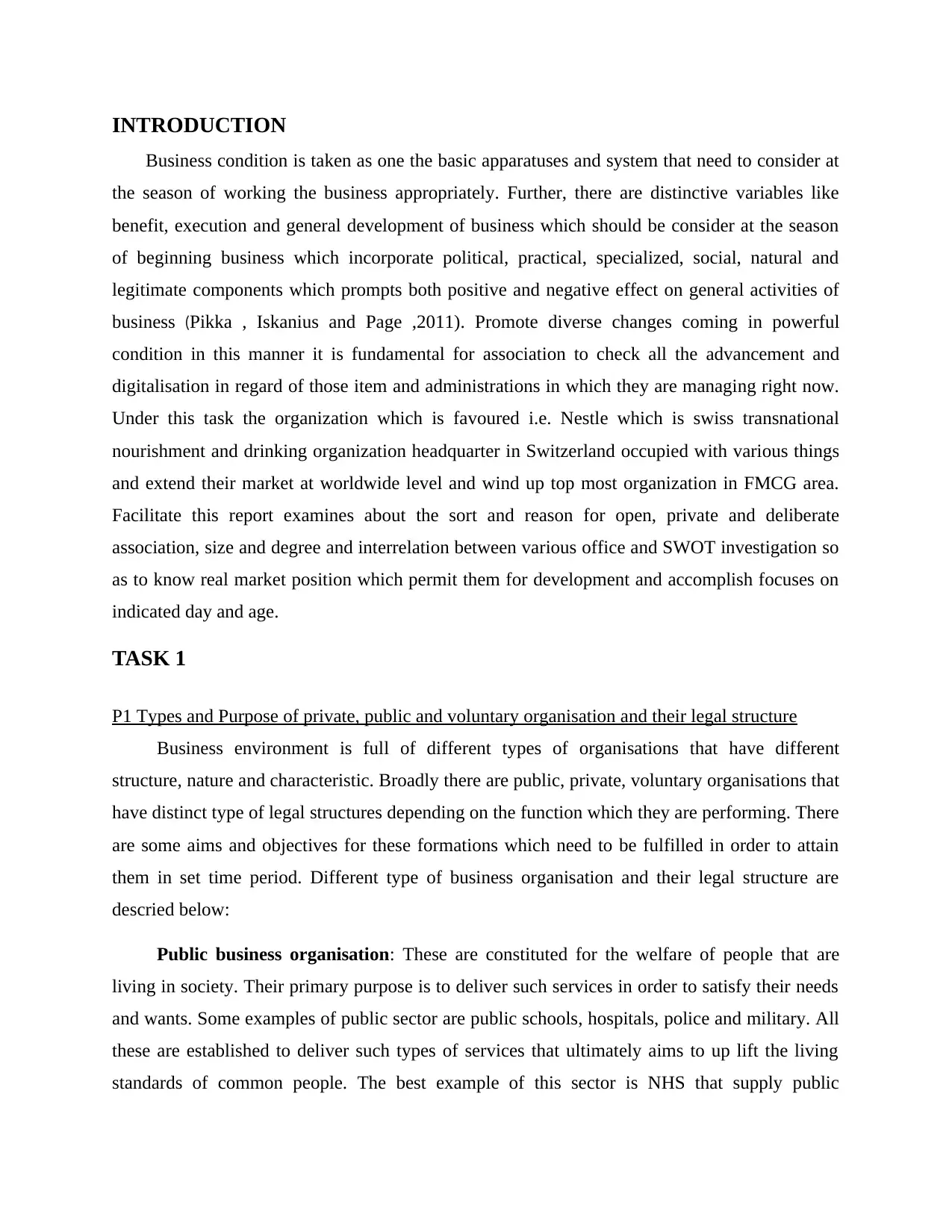
INTRODUCTION
Business condition is taken as one the basic apparatuses and system that need to consider at
the season of working the business appropriately. Further, there are distinctive variables like
benefit, execution and general development of business which should be consider at the season
of beginning business which incorporate political, practical, specialized, social, natural and
legitimate components which prompts both positive and negative effect on general activities of
business (Pikka , Iskanius and Page ,2011). Promote diverse changes coming in powerful
condition in this manner it is fundamental for association to check all the advancement and
digitalisation in regard of those item and administrations in which they are managing right now.
Under this task the organization which is favoured i.e. Nestle which is swiss transnational
nourishment and drinking organization headquarter in Switzerland occupied with various things
and extend their market at worldwide level and wind up top most organization in FMCG area.
Facilitate this report examines about the sort and reason for open, private and deliberate
association, size and degree and interrelation between various office and SWOT investigation so
as to know real market position which permit them for development and accomplish focuses on
indicated day and age.
TASK 1
P1 Types and Purpose of private, public and voluntary organisation and their legal structure
Business environment is full of different types of organisations that have different
structure, nature and characteristic. Broadly there are public, private, voluntary organisations that
have distinct type of legal structures depending on the function which they are performing. There
are some aims and objectives for these formations which need to be fulfilled in order to attain
them in set time period. Different type of business organisation and their legal structure are
descried below:
Public business organisation: These are constituted for the welfare of people that are
living in society. Their primary purpose is to deliver such services in order to satisfy their needs
and wants. Some examples of public sector are public schools, hospitals, police and military. All
these are established to deliver such types of services that ultimately aims to up lift the living
standards of common people. The best example of this sector is NHS that supply public
Business condition is taken as one the basic apparatuses and system that need to consider at
the season of working the business appropriately. Further, there are distinctive variables like
benefit, execution and general development of business which should be consider at the season
of beginning business which incorporate political, practical, specialized, social, natural and
legitimate components which prompts both positive and negative effect on general activities of
business (Pikka , Iskanius and Page ,2011). Promote diverse changes coming in powerful
condition in this manner it is fundamental for association to check all the advancement and
digitalisation in regard of those item and administrations in which they are managing right now.
Under this task the organization which is favoured i.e. Nestle which is swiss transnational
nourishment and drinking organization headquarter in Switzerland occupied with various things
and extend their market at worldwide level and wind up top most organization in FMCG area.
Facilitate this report examines about the sort and reason for open, private and deliberate
association, size and degree and interrelation between various office and SWOT investigation so
as to know real market position which permit them for development and accomplish focuses on
indicated day and age.
TASK 1
P1 Types and Purpose of private, public and voluntary organisation and their legal structure
Business environment is full of different types of organisations that have different
structure, nature and characteristic. Broadly there are public, private, voluntary organisations that
have distinct type of legal structures depending on the function which they are performing. There
are some aims and objectives for these formations which need to be fulfilled in order to attain
them in set time period. Different type of business organisation and their legal structure are
descried below:
Public business organisation: These are constituted for the welfare of people that are
living in society. Their primary purpose is to deliver such services in order to satisfy their needs
and wants. Some examples of public sector are public schools, hospitals, police and military. All
these are established to deliver such types of services that ultimately aims to up lift the living
standards of common people. The best example of this sector is NHS that supply public
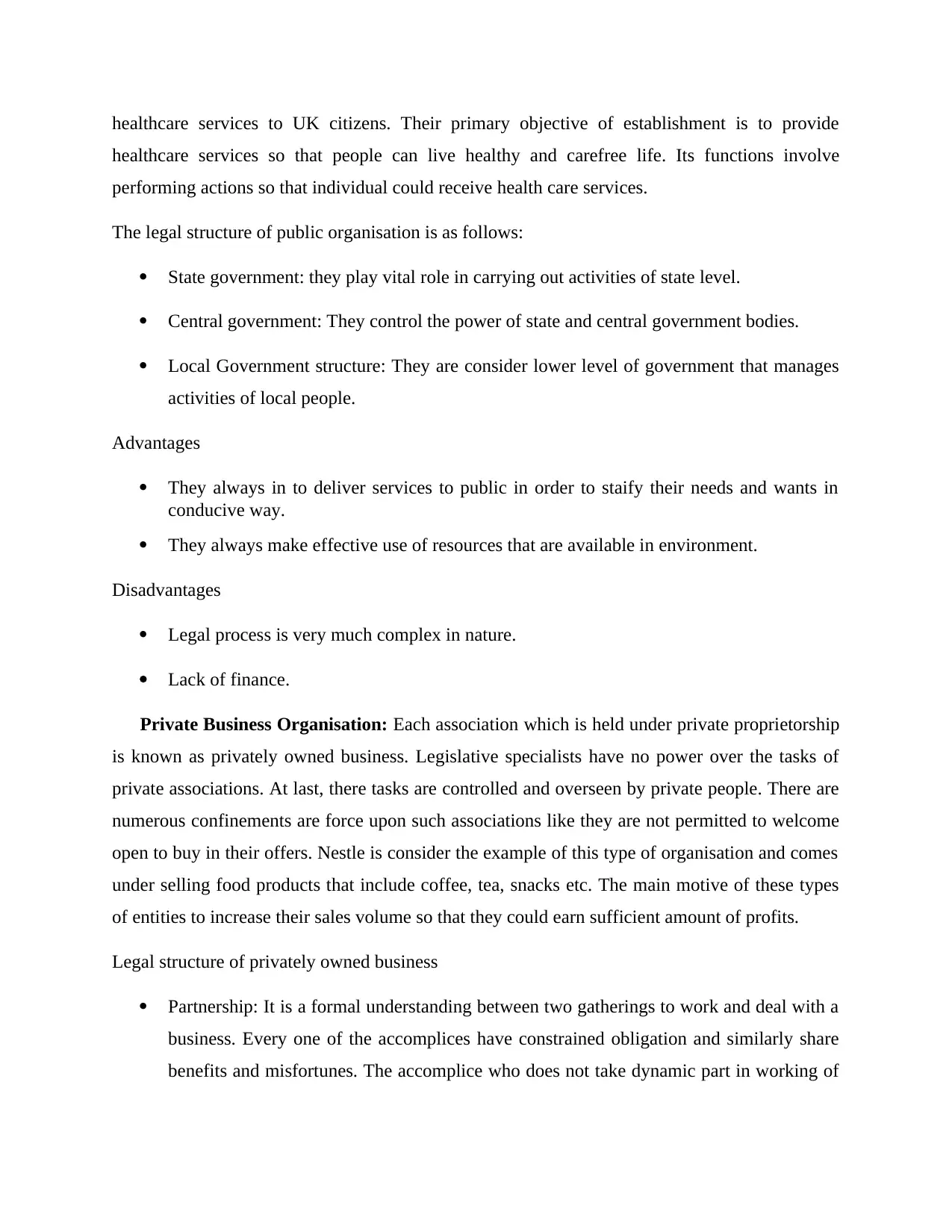
healthcare services to UK citizens. Their primary objective of establishment is to provide
healthcare services so that people can live healthy and carefree life. Its functions involve
performing actions so that individual could receive health care services.
The legal structure of public organisation is as follows:
State government: they play vital role in carrying out activities of state level.
Central government: They control the power of state and central government bodies.
Local Government structure: They are consider lower level of government that manages
activities of local people.
Advantages
They always in to deliver services to public in order to staify their needs and wants in
conducive way.
They always make effective use of resources that are available in environment.
Disadvantages
Legal process is very much complex in nature.
Lack of finance.
Private Business Organisation: Each association which is held under private proprietorship
is known as privately owned business. Legislative specialists have no power over the tasks of
private associations. At last, there tasks are controlled and overseen by private people. There are
numerous confinements are force upon such associations like they are not permitted to welcome
open to buy in their offers. Nestle is consider the example of this type of organisation and comes
under selling food products that include coffee, tea, snacks etc. The main motive of these types
of entities to increase their sales volume so that they could earn sufficient amount of profits.
Legal structure of privately owned business
Partnership: It is a formal understanding between two gatherings to work and deal with a
business. Every one of the accomplices have constrained obligation and similarly share
benefits and misfortunes. The accomplice who does not take dynamic part in working of
healthcare services so that people can live healthy and carefree life. Its functions involve
performing actions so that individual could receive health care services.
The legal structure of public organisation is as follows:
State government: they play vital role in carrying out activities of state level.
Central government: They control the power of state and central government bodies.
Local Government structure: They are consider lower level of government that manages
activities of local people.
Advantages
They always in to deliver services to public in order to staify their needs and wants in
conducive way.
They always make effective use of resources that are available in environment.
Disadvantages
Legal process is very much complex in nature.
Lack of finance.
Private Business Organisation: Each association which is held under private proprietorship
is known as privately owned business. Legislative specialists have no power over the tasks of
private associations. At last, there tasks are controlled and overseen by private people. There are
numerous confinements are force upon such associations like they are not permitted to welcome
open to buy in their offers. Nestle is consider the example of this type of organisation and comes
under selling food products that include coffee, tea, snacks etc. The main motive of these types
of entities to increase their sales volume so that they could earn sufficient amount of profits.
Legal structure of privately owned business
Partnership: It is a formal understanding between two gatherings to work and deal with a
business. Every one of the accomplices have constrained obligation and similarly share
benefits and misfortunes. The accomplice who does not take dynamic part in working of
Secure Best Marks with AI Grader
Need help grading? Try our AI Grader for instant feedback on your assignments.
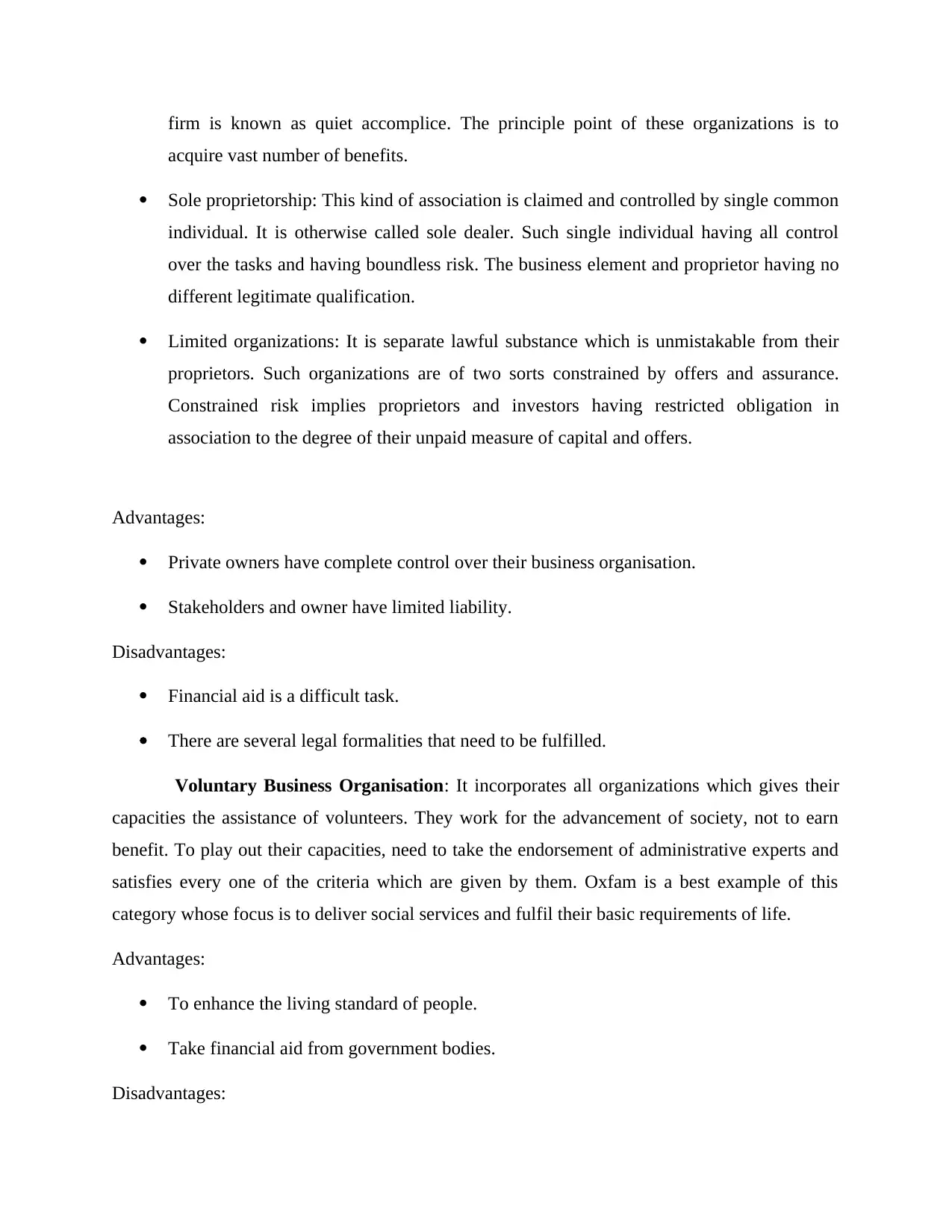
firm is known as quiet accomplice. The principle point of these organizations is to
acquire vast number of benefits.
Sole proprietorship: This kind of association is claimed and controlled by single common
individual. It is otherwise called sole dealer. Such single individual having all control
over the tasks and having boundless risk. The business element and proprietor having no
different legitimate qualification.
Limited organizations: It is separate lawful substance which is unmistakable from their
proprietors. Such organizations are of two sorts constrained by offers and assurance.
Constrained risk implies proprietors and investors having restricted obligation in
association to the degree of their unpaid measure of capital and offers.
Advantages:
Private owners have complete control over their business organisation.
Stakeholders and owner have limited liability.
Disadvantages:
Financial aid is a difficult task.
There are several legal formalities that need to be fulfilled.
Voluntary Business Organisation: It incorporates all organizations which gives their
capacities the assistance of volunteers. They work for the advancement of society, not to earn
benefit. To play out their capacities, need to take the endorsement of administrative experts and
satisfies every one of the criteria which are given by them. Oxfam is a best example of this
category whose focus is to deliver social services and fulfil their basic requirements of life.
Advantages:
To enhance the living standard of people.
Take financial aid from government bodies.
Disadvantages:
acquire vast number of benefits.
Sole proprietorship: This kind of association is claimed and controlled by single common
individual. It is otherwise called sole dealer. Such single individual having all control
over the tasks and having boundless risk. The business element and proprietor having no
different legitimate qualification.
Limited organizations: It is separate lawful substance which is unmistakable from their
proprietors. Such organizations are of two sorts constrained by offers and assurance.
Constrained risk implies proprietors and investors having restricted obligation in
association to the degree of their unpaid measure of capital and offers.
Advantages:
Private owners have complete control over their business organisation.
Stakeholders and owner have limited liability.
Disadvantages:
Financial aid is a difficult task.
There are several legal formalities that need to be fulfilled.
Voluntary Business Organisation: It incorporates all organizations which gives their
capacities the assistance of volunteers. They work for the advancement of society, not to earn
benefit. To play out their capacities, need to take the endorsement of administrative experts and
satisfies every one of the criteria which are given by them. Oxfam is a best example of this
category whose focus is to deliver social services and fulfil their basic requirements of life.
Advantages:
To enhance the living standard of people.
Take financial aid from government bodies.
Disadvantages:
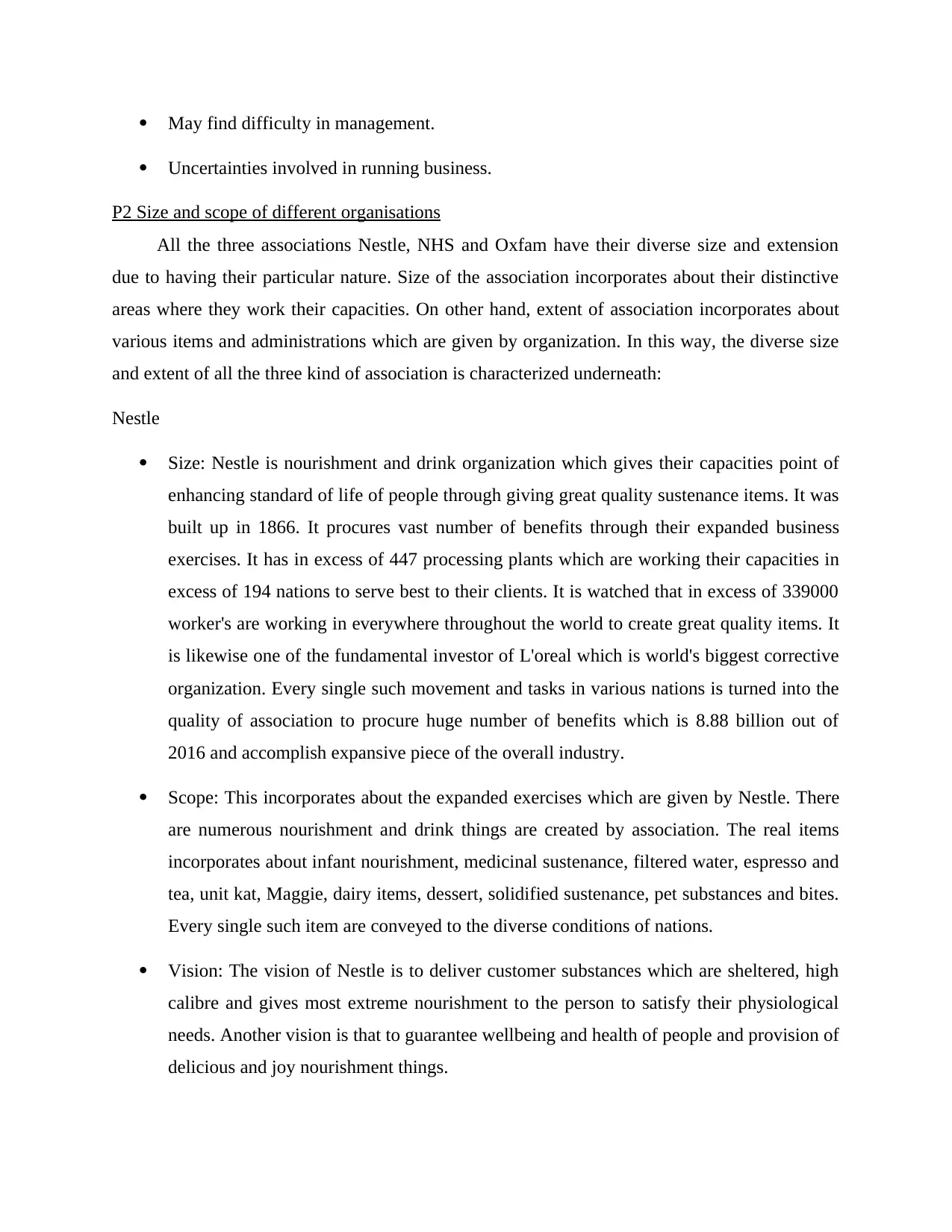
May find difficulty in management.
Uncertainties involved in running business.
P2 Size and scope of different organisations
All the three associations Nestle, NHS and Oxfam have their diverse size and extension
due to having their particular nature. Size of the association incorporates about their distinctive
areas where they work their capacities. On other hand, extent of association incorporates about
various items and administrations which are given by organization. In this way, the diverse size
and extent of all the three kind of association is characterized underneath:
Nestle
Size: Nestle is nourishment and drink organization which gives their capacities point of
enhancing standard of life of people through giving great quality sustenance items. It was
built up in 1866. It procures vast number of benefits through their expanded business
exercises. It has in excess of 447 processing plants which are working their capacities in
excess of 194 nations to serve best to their clients. It is watched that in excess of 339000
worker's are working in everywhere throughout the world to create great quality items. It
is likewise one of the fundamental investor of L'oreal which is world's biggest corrective
organization. Every single such movement and tasks in various nations is turned into the
quality of association to procure huge number of benefits which is 8.88 billion out of
2016 and accomplish expansive piece of the overall industry.
Scope: This incorporates about the expanded exercises which are given by Nestle. There
are numerous nourishment and drink things are created by association. The real items
incorporates about infant nourishment, medicinal sustenance, filtered water, espresso and
tea, unit kat, Maggie, dairy items, dessert, solidified sustenance, pet substances and bites.
Every single such item are conveyed to the diverse conditions of nations.
Vision: The vision of Nestle is to deliver customer substances which are sheltered, high
calibre and gives most extreme nourishment to the person to satisfy their physiological
needs. Another vision is that to guarantee wellbeing and health of people and provision of
delicious and joy nourishment things.
Uncertainties involved in running business.
P2 Size and scope of different organisations
All the three associations Nestle, NHS and Oxfam have their diverse size and extension
due to having their particular nature. Size of the association incorporates about their distinctive
areas where they work their capacities. On other hand, extent of association incorporates about
various items and administrations which are given by organization. In this way, the diverse size
and extent of all the three kind of association is characterized underneath:
Nestle
Size: Nestle is nourishment and drink organization which gives their capacities point of
enhancing standard of life of people through giving great quality sustenance items. It was
built up in 1866. It procures vast number of benefits through their expanded business
exercises. It has in excess of 447 processing plants which are working their capacities in
excess of 194 nations to serve best to their clients. It is watched that in excess of 339000
worker's are working in everywhere throughout the world to create great quality items. It
is likewise one of the fundamental investor of L'oreal which is world's biggest corrective
organization. Every single such movement and tasks in various nations is turned into the
quality of association to procure huge number of benefits which is 8.88 billion out of
2016 and accomplish expansive piece of the overall industry.
Scope: This incorporates about the expanded exercises which are given by Nestle. There
are numerous nourishment and drink things are created by association. The real items
incorporates about infant nourishment, medicinal sustenance, filtered water, espresso and
tea, unit kat, Maggie, dairy items, dessert, solidified sustenance, pet substances and bites.
Every single such item are conveyed to the diverse conditions of nations.
Vision: The vision of Nestle is to deliver customer substances which are sheltered, high
calibre and gives most extreme nourishment to the person to satisfy their physiological
needs. Another vision is that to guarantee wellbeing and health of people and provision of
delicious and joy nourishment things.
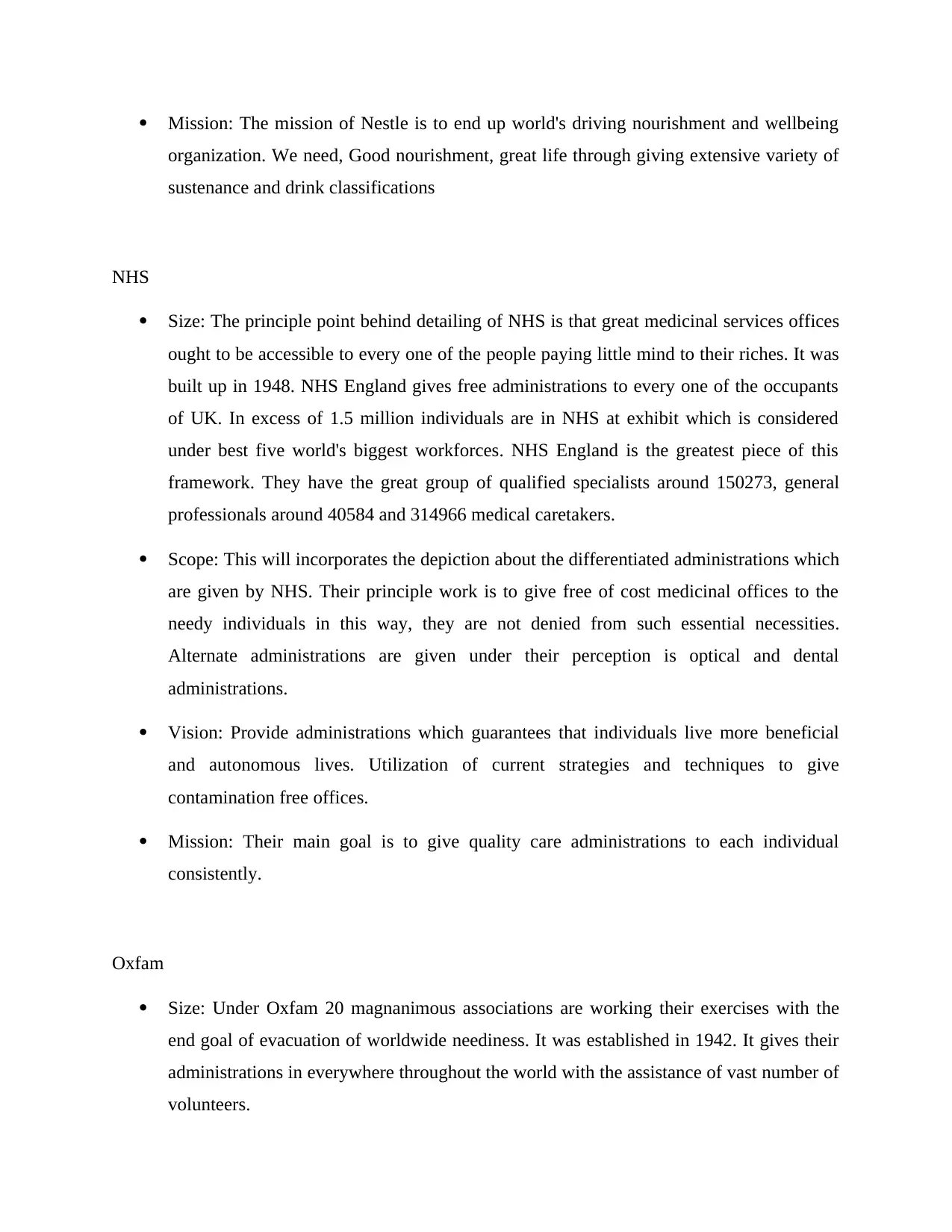
Mission: The mission of Nestle is to end up world's driving nourishment and wellbeing
organization. We need, Good nourishment, great life through giving extensive variety of
sustenance and drink classifications
NHS
Size: The principle point behind detailing of NHS is that great medicinal services offices
ought to be accessible to every one of the people paying little mind to their riches. It was
built up in 1948. NHS England gives free administrations to every one of the occupants
of UK. In excess of 1.5 million individuals are in NHS at exhibit which is considered
under best five world's biggest workforces. NHS England is the greatest piece of this
framework. They have the great group of qualified specialists around 150273, general
professionals around 40584 and 314966 medical caretakers.
Scope: This will incorporates the depiction about the differentiated administrations which
are given by NHS. Their principle work is to give free of cost medicinal offices to the
needy individuals in this way, they are not denied from such essential necessities.
Alternate administrations are given under their perception is optical and dental
administrations.
Vision: Provide administrations which guarantees that individuals live more beneficial
and autonomous lives. Utilization of current strategies and techniques to give
contamination free offices.
Mission: Their main goal is to give quality care administrations to each individual
consistently.
Oxfam
Size: Under Oxfam 20 magnanimous associations are working their exercises with the
end goal of evacuation of worldwide neediness. It was established in 1942. It gives their
administrations in everywhere throughout the world with the assistance of vast number of
volunteers.
organization. We need, Good nourishment, great life through giving extensive variety of
sustenance and drink classifications
NHS
Size: The principle point behind detailing of NHS is that great medicinal services offices
ought to be accessible to every one of the people paying little mind to their riches. It was
built up in 1948. NHS England gives free administrations to every one of the occupants
of UK. In excess of 1.5 million individuals are in NHS at exhibit which is considered
under best five world's biggest workforces. NHS England is the greatest piece of this
framework. They have the great group of qualified specialists around 150273, general
professionals around 40584 and 314966 medical caretakers.
Scope: This will incorporates the depiction about the differentiated administrations which
are given by NHS. Their principle work is to give free of cost medicinal offices to the
needy individuals in this way, they are not denied from such essential necessities.
Alternate administrations are given under their perception is optical and dental
administrations.
Vision: Provide administrations which guarantees that individuals live more beneficial
and autonomous lives. Utilization of current strategies and techniques to give
contamination free offices.
Mission: Their main goal is to give quality care administrations to each individual
consistently.
Oxfam
Size: Under Oxfam 20 magnanimous associations are working their exercises with the
end goal of evacuation of worldwide neediness. It was established in 1942. It gives their
administrations in everywhere throughout the world with the assistance of vast number of
volunteers.
Paraphrase This Document
Need a fresh take? Get an instant paraphrase of this document with our AI Paraphraser
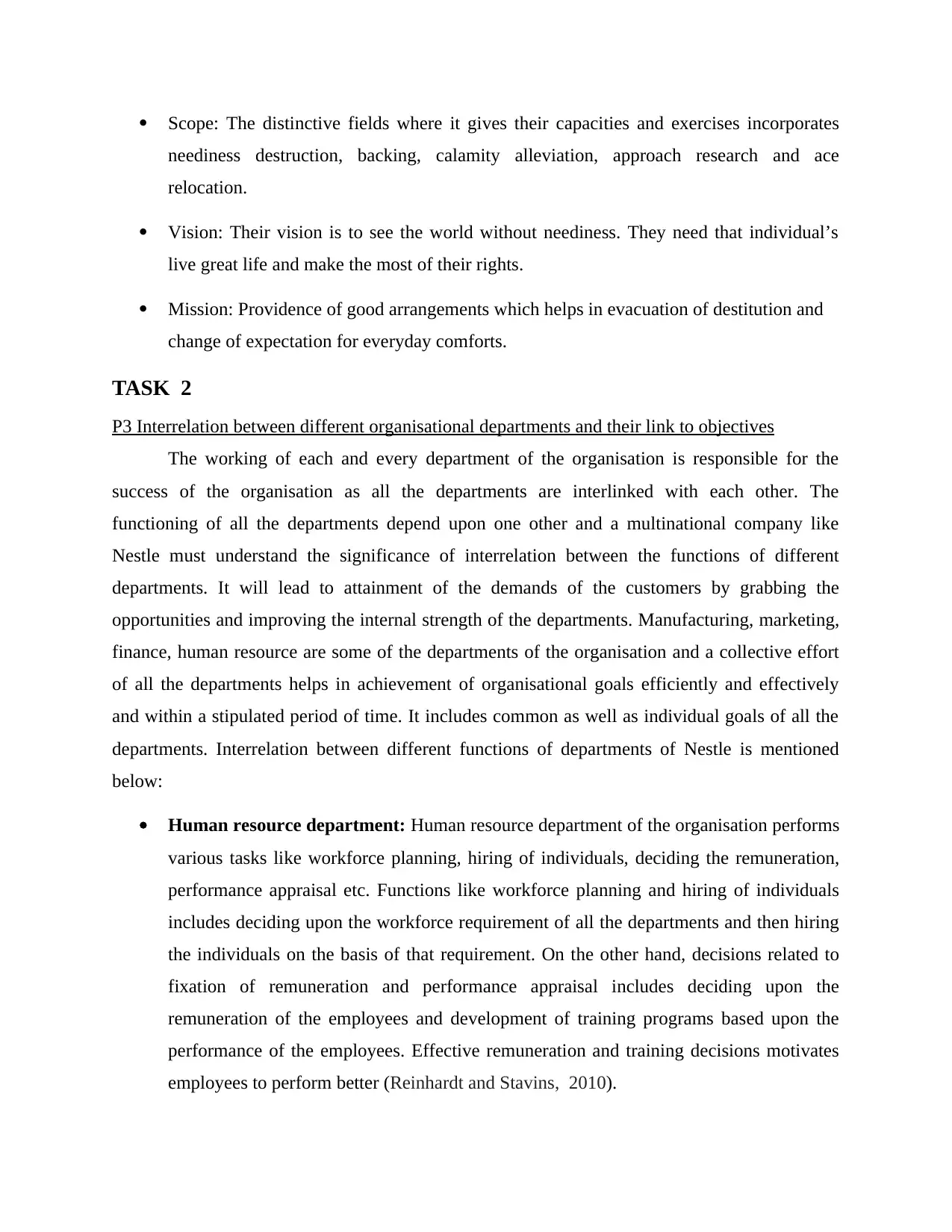
Scope: The distinctive fields where it gives their capacities and exercises incorporates
neediness destruction, backing, calamity alleviation, approach research and ace
relocation.
Vision: Their vision is to see the world without neediness. They need that individual’s
live great life and make the most of their rights.
Mission: Providence of good arrangements which helps in evacuation of destitution and
change of expectation for everyday comforts.
TASK 2
P3 Interrelation between different organisational departments and their link to objectives
The working of each and every department of the organisation is responsible for the
success of the organisation as all the departments are interlinked with each other. The
functioning of all the departments depend upon one other and a multinational company like
Nestle must understand the significance of interrelation between the functions of different
departments. It will lead to attainment of the demands of the customers by grabbing the
opportunities and improving the internal strength of the departments. Manufacturing, marketing,
finance, human resource are some of the departments of the organisation and a collective effort
of all the departments helps in achievement of organisational goals efficiently and effectively
and within a stipulated period of time. It includes common as well as individual goals of all the
departments. Interrelation between different functions of departments of Nestle is mentioned
below:
Human resource department: Human resource department of the organisation performs
various tasks like workforce planning, hiring of individuals, deciding the remuneration,
performance appraisal etc. Functions like workforce planning and hiring of individuals
includes deciding upon the workforce requirement of all the departments and then hiring
the individuals on the basis of that requirement. On the other hand, decisions related to
fixation of remuneration and performance appraisal includes deciding upon the
remuneration of the employees and development of training programs based upon the
performance of the employees. Effective remuneration and training decisions motivates
employees to perform better (Reinhardt and Stavins, 2010).
neediness destruction, backing, calamity alleviation, approach research and ace
relocation.
Vision: Their vision is to see the world without neediness. They need that individual’s
live great life and make the most of their rights.
Mission: Providence of good arrangements which helps in evacuation of destitution and
change of expectation for everyday comforts.
TASK 2
P3 Interrelation between different organisational departments and their link to objectives
The working of each and every department of the organisation is responsible for the
success of the organisation as all the departments are interlinked with each other. The
functioning of all the departments depend upon one other and a multinational company like
Nestle must understand the significance of interrelation between the functions of different
departments. It will lead to attainment of the demands of the customers by grabbing the
opportunities and improving the internal strength of the departments. Manufacturing, marketing,
finance, human resource are some of the departments of the organisation and a collective effort
of all the departments helps in achievement of organisational goals efficiently and effectively
and within a stipulated period of time. It includes common as well as individual goals of all the
departments. Interrelation between different functions of departments of Nestle is mentioned
below:
Human resource department: Human resource department of the organisation performs
various tasks like workforce planning, hiring of individuals, deciding the remuneration,
performance appraisal etc. Functions like workforce planning and hiring of individuals
includes deciding upon the workforce requirement of all the departments and then hiring
the individuals on the basis of that requirement. On the other hand, decisions related to
fixation of remuneration and performance appraisal includes deciding upon the
remuneration of the employees and development of training programs based upon the
performance of the employees. Effective remuneration and training decisions motivates
employees to perform better (Reinhardt and Stavins, 2010).
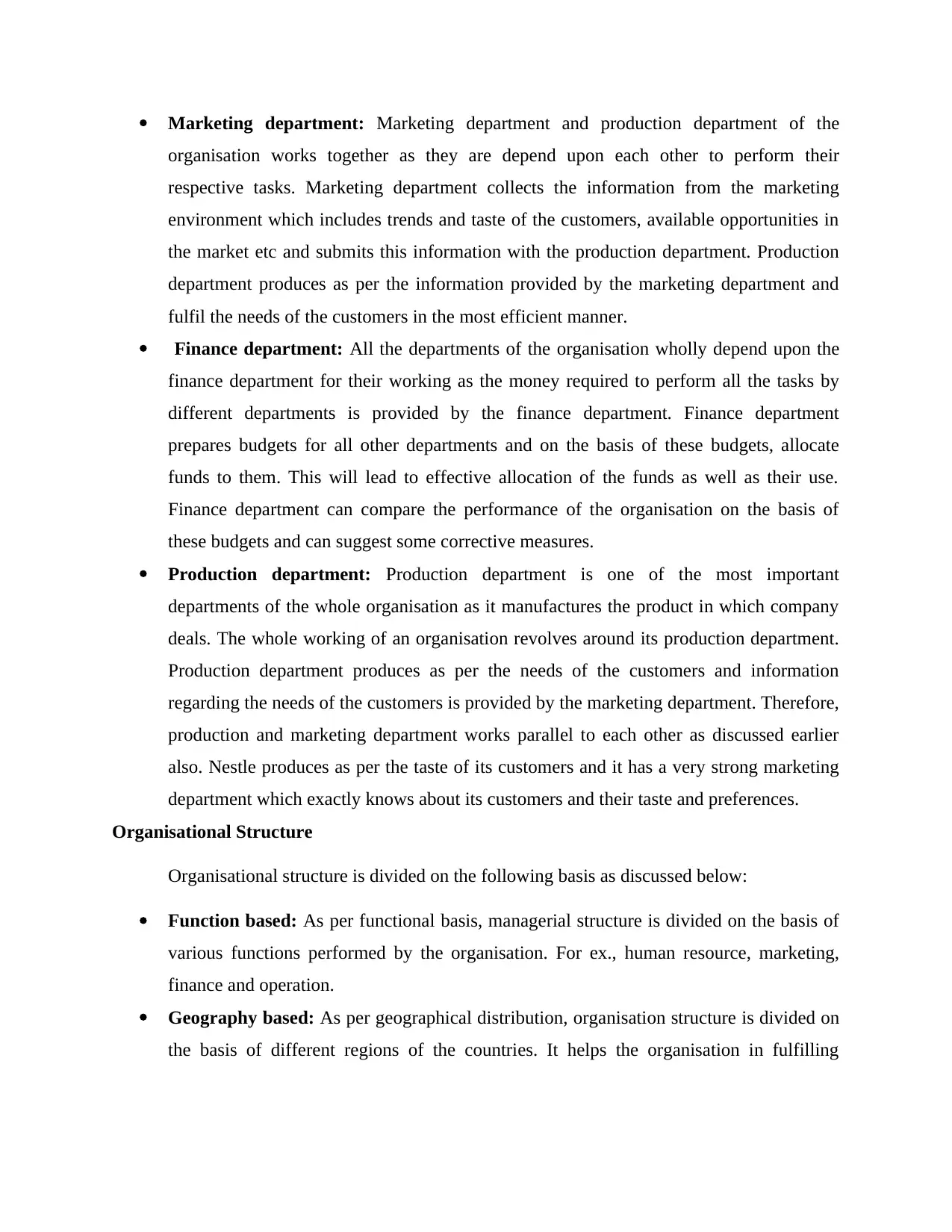
Marketing department: Marketing department and production department of the
organisation works together as they are depend upon each other to perform their
respective tasks. Marketing department collects the information from the marketing
environment which includes trends and taste of the customers, available opportunities in
the market etc and submits this information with the production department. Production
department produces as per the information provided by the marketing department and
fulfil the needs of the customers in the most efficient manner.
Finance department: All the departments of the organisation wholly depend upon the
finance department for their working as the money required to perform all the tasks by
different departments is provided by the finance department. Finance department
prepares budgets for all other departments and on the basis of these budgets, allocate
funds to them. This will lead to effective allocation of the funds as well as their use.
Finance department can compare the performance of the organisation on the basis of
these budgets and can suggest some corrective measures.
Production department: Production department is one of the most important
departments of the whole organisation as it manufactures the product in which company
deals. The whole working of an organisation revolves around its production department.
Production department produces as per the needs of the customers and information
regarding the needs of the customers is provided by the marketing department. Therefore,
production and marketing department works parallel to each other as discussed earlier
also. Nestle produces as per the taste of its customers and it has a very strong marketing
department which exactly knows about its customers and their taste and preferences.
Organisational Structure
Organisational structure is divided on the following basis as discussed below:
Function based: As per functional basis, managerial structure is divided on the basis of
various functions performed by the organisation. For ex., human resource, marketing,
finance and operation.
Geography based: As per geographical distribution, organisation structure is divided on
the basis of different regions of the countries. It helps the organisation in fulfilling
organisation works together as they are depend upon each other to perform their
respective tasks. Marketing department collects the information from the marketing
environment which includes trends and taste of the customers, available opportunities in
the market etc and submits this information with the production department. Production
department produces as per the information provided by the marketing department and
fulfil the needs of the customers in the most efficient manner.
Finance department: All the departments of the organisation wholly depend upon the
finance department for their working as the money required to perform all the tasks by
different departments is provided by the finance department. Finance department
prepares budgets for all other departments and on the basis of these budgets, allocate
funds to them. This will lead to effective allocation of the funds as well as their use.
Finance department can compare the performance of the organisation on the basis of
these budgets and can suggest some corrective measures.
Production department: Production department is one of the most important
departments of the whole organisation as it manufactures the product in which company
deals. The whole working of an organisation revolves around its production department.
Production department produces as per the needs of the customers and information
regarding the needs of the customers is provided by the marketing department. Therefore,
production and marketing department works parallel to each other as discussed earlier
also. Nestle produces as per the taste of its customers and it has a very strong marketing
department which exactly knows about its customers and their taste and preferences.
Organisational Structure
Organisational structure is divided on the following basis as discussed below:
Function based: As per functional basis, managerial structure is divided on the basis of
various functions performed by the organisation. For ex., human resource, marketing,
finance and operation.
Geography based: As per geographical distribution, organisation structure is divided on
the basis of different regions of the countries. It helps the organisation in fulfilling
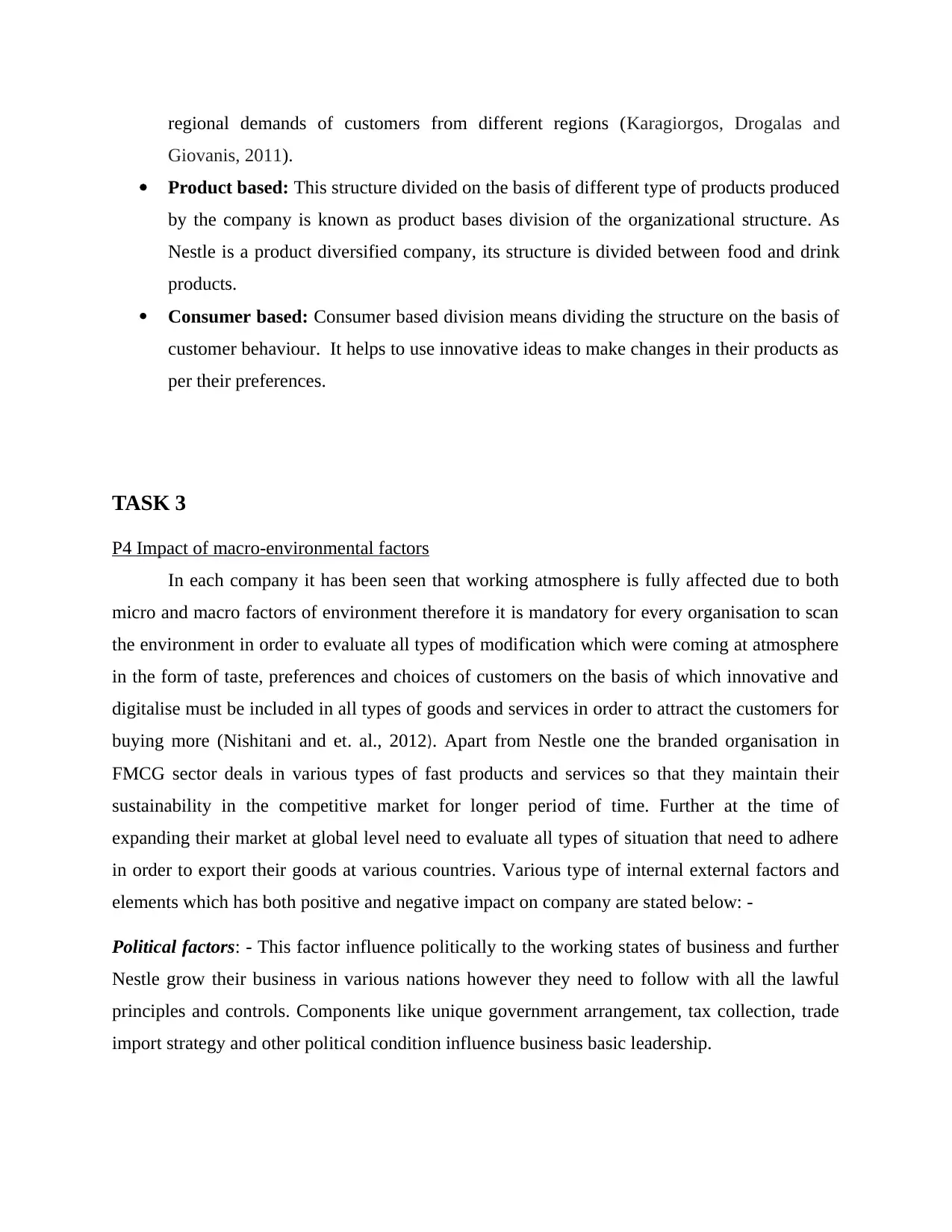
regional demands of customers from different regions (Karagiorgos, Drogalas and
Giovanis, 2011).
Product based: This structure divided on the basis of different type of products produced
by the company is known as product bases division of the organizational structure. As
Nestle is a product diversified company, its structure is divided between food and drink
products.
Consumer based: Consumer based division means dividing the structure on the basis of
customer behaviour. It helps to use innovative ideas to make changes in their products as
per their preferences.
TASK 3
P4 Impact of macro-environmental factors
In each company it has been seen that working atmosphere is fully affected due to both
micro and macro factors of environment therefore it is mandatory for every organisation to scan
the environment in order to evaluate all types of modification which were coming at atmosphere
in the form of taste, preferences and choices of customers on the basis of which innovative and
digitalise must be included in all types of goods and services in order to attract the customers for
buying more (Nishitani and et. al., 2012). Apart from Nestle one the branded organisation in
FMCG sector deals in various types of fast products and services so that they maintain their
sustainability in the competitive market for longer period of time. Further at the time of
expanding their market at global level need to evaluate all types of situation that need to adhere
in order to export their goods at various countries. Various type of internal external factors and
elements which has both positive and negative impact on company are stated below: -
Political factors: - This factor influence politically to the working states of business and further
Nestle grow their business in various nations however they need to follow with all the lawful
principles and controls. Components like unique government arrangement, tax collection, trade
import strategy and other political condition influence business basic leadership.
Giovanis, 2011).
Product based: This structure divided on the basis of different type of products produced
by the company is known as product bases division of the organizational structure. As
Nestle is a product diversified company, its structure is divided between food and drink
products.
Consumer based: Consumer based division means dividing the structure on the basis of
customer behaviour. It helps to use innovative ideas to make changes in their products as
per their preferences.
TASK 3
P4 Impact of macro-environmental factors
In each company it has been seen that working atmosphere is fully affected due to both
micro and macro factors of environment therefore it is mandatory for every organisation to scan
the environment in order to evaluate all types of modification which were coming at atmosphere
in the form of taste, preferences and choices of customers on the basis of which innovative and
digitalise must be included in all types of goods and services in order to attract the customers for
buying more (Nishitani and et. al., 2012). Apart from Nestle one the branded organisation in
FMCG sector deals in various types of fast products and services so that they maintain their
sustainability in the competitive market for longer period of time. Further at the time of
expanding their market at global level need to evaluate all types of situation that need to adhere
in order to export their goods at various countries. Various type of internal external factors and
elements which has both positive and negative impact on company are stated below: -
Political factors: - This factor influence politically to the working states of business and further
Nestle grow their business in various nations however they need to follow with all the lawful
principles and controls. Components like unique government arrangement, tax collection, trade
import strategy and other political condition influence business basic leadership.
Secure Best Marks with AI Grader
Need help grading? Try our AI Grader for instant feedback on your assignments.
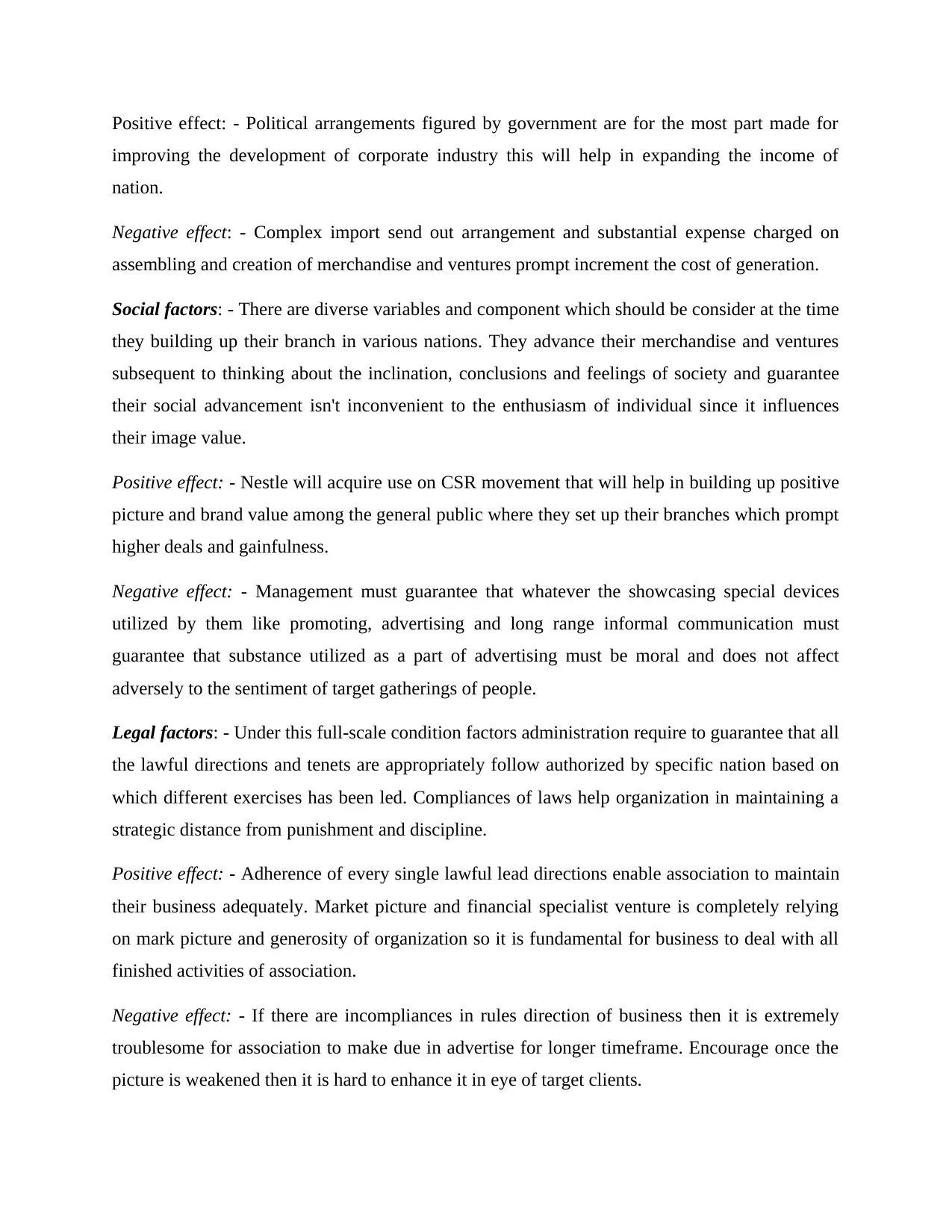
Positive effect: - Political arrangements figured by government are for the most part made for
improving the development of corporate industry this will help in expanding the income of
nation.
Negative effect: - Complex import send out arrangement and substantial expense charged on
assembling and creation of merchandise and ventures prompt increment the cost of generation.
Social factors: - There are diverse variables and component which should be consider at the time
they building up their branch in various nations. They advance their merchandise and ventures
subsequent to thinking about the inclination, conclusions and feelings of society and guarantee
their social advancement isn't inconvenient to the enthusiasm of individual since it influences
their image value.
Positive effect: - Nestle will acquire use on CSR movement that will help in building up positive
picture and brand value among the general public where they set up their branches which prompt
higher deals and gainfulness.
Negative effect: - Management must guarantee that whatever the showcasing special devices
utilized by them like promoting, advertising and long range informal communication must
guarantee that substance utilized as a part of advertising must be moral and does not affect
adversely to the sentiment of target gatherings of people.
Legal factors: - Under this full-scale condition factors administration require to guarantee that all
the lawful directions and tenets are appropriately follow authorized by specific nation based on
which different exercises has been led. Compliances of laws help organization in maintaining a
strategic distance from punishment and discipline.
Positive effect: - Adherence of every single lawful lead directions enable association to maintain
their business adequately. Market picture and financial specialist venture is completely relying
on mark picture and generosity of organization so it is fundamental for business to deal with all
finished activities of association.
Negative effect: - If there are incompliances in rules direction of business then it is extremely
troublesome for association to make due in advertise for longer timeframe. Encourage once the
picture is weakened then it is hard to enhance it in eye of target clients.
improving the development of corporate industry this will help in expanding the income of
nation.
Negative effect: - Complex import send out arrangement and substantial expense charged on
assembling and creation of merchandise and ventures prompt increment the cost of generation.
Social factors: - There are diverse variables and component which should be consider at the time
they building up their branch in various nations. They advance their merchandise and ventures
subsequent to thinking about the inclination, conclusions and feelings of society and guarantee
their social advancement isn't inconvenient to the enthusiasm of individual since it influences
their image value.
Positive effect: - Nestle will acquire use on CSR movement that will help in building up positive
picture and brand value among the general public where they set up their branches which prompt
higher deals and gainfulness.
Negative effect: - Management must guarantee that whatever the showcasing special devices
utilized by them like promoting, advertising and long range informal communication must
guarantee that substance utilized as a part of advertising must be moral and does not affect
adversely to the sentiment of target gatherings of people.
Legal factors: - Under this full-scale condition factors administration require to guarantee that all
the lawful directions and tenets are appropriately follow authorized by specific nation based on
which different exercises has been led. Compliances of laws help organization in maintaining a
strategic distance from punishment and discipline.
Positive effect: - Adherence of every single lawful lead directions enable association to maintain
their business adequately. Market picture and financial specialist venture is completely relying
on mark picture and generosity of organization so it is fundamental for business to deal with all
finished activities of association.
Negative effect: - If there are incompliances in rules direction of business then it is extremely
troublesome for association to make due in advertise for longer timeframe. Encourage once the
picture is weakened then it is hard to enhance it in eye of target clients.
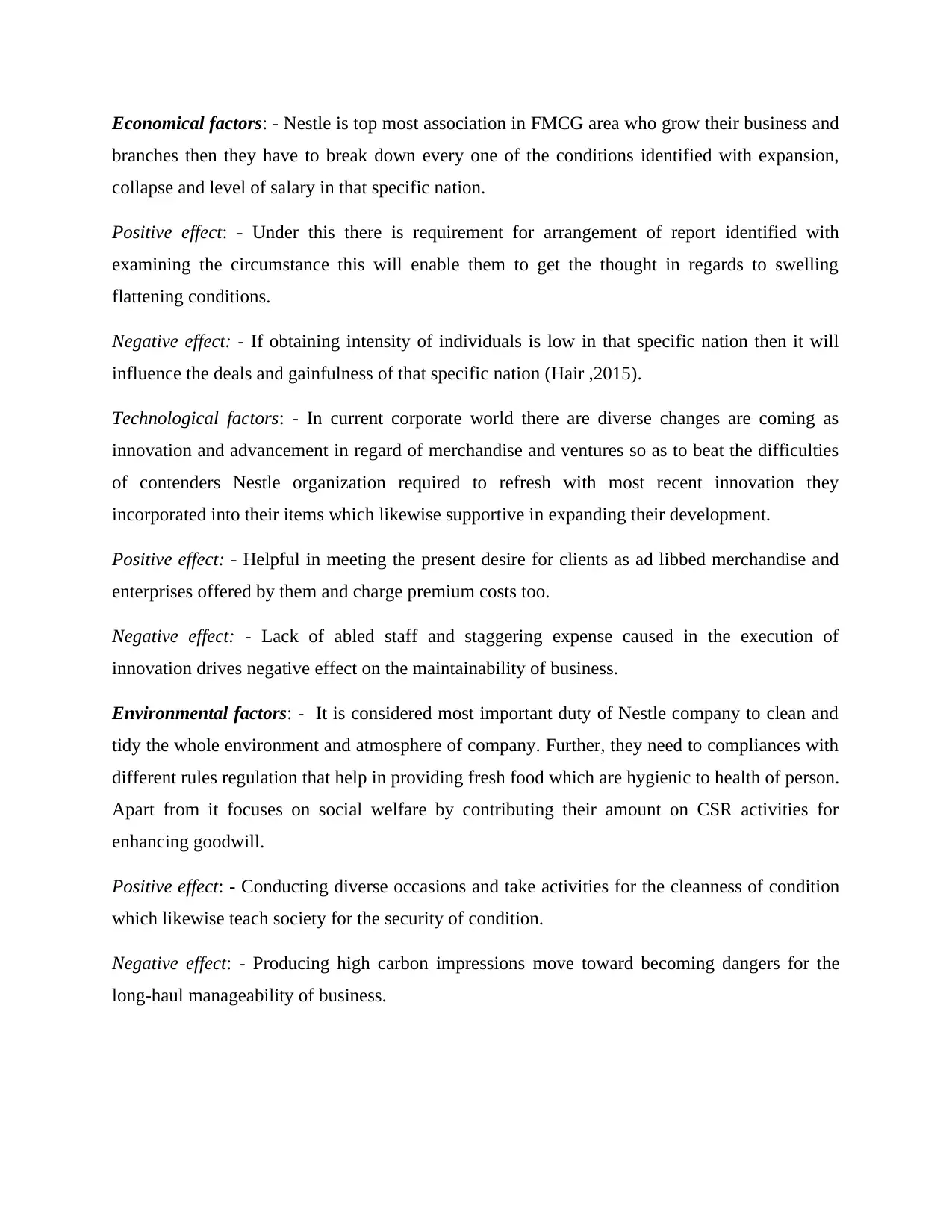
Economical factors: - Nestle is top most association in FMCG area who grow their business and
branches then they have to break down every one of the conditions identified with expansion,
collapse and level of salary in that specific nation.
Positive effect: - Under this there is requirement for arrangement of report identified with
examining the circumstance this will enable them to get the thought in regards to swelling
flattening conditions.
Negative effect: - If obtaining intensity of individuals is low in that specific nation then it will
influence the deals and gainfulness of that specific nation (Hair ,2015).
Technological factors: - In current corporate world there are diverse changes are coming as
innovation and advancement in regard of merchandise and ventures so as to beat the difficulties
of contenders Nestle organization required to refresh with most recent innovation they
incorporated into their items which likewise supportive in expanding their development.
Positive effect: - Helpful in meeting the present desire for clients as ad libbed merchandise and
enterprises offered by them and charge premium costs too.
Negative effect: - Lack of abled staff and staggering expense caused in the execution of
innovation drives negative effect on the maintainability of business.
Environmental factors: - It is considered most important duty of Nestle company to clean and
tidy the whole environment and atmosphere of company. Further, they need to compliances with
different rules regulation that help in providing fresh food which are hygienic to health of person.
Apart from it focuses on social welfare by contributing their amount on CSR activities for
enhancing goodwill.
Positive effect: - Conducting diverse occasions and take activities for the cleanness of condition
which likewise teach society for the security of condition.
Negative effect: - Producing high carbon impressions move toward becoming dangers for the
long-haul manageability of business.
branches then they have to break down every one of the conditions identified with expansion,
collapse and level of salary in that specific nation.
Positive effect: - Under this there is requirement for arrangement of report identified with
examining the circumstance this will enable them to get the thought in regards to swelling
flattening conditions.
Negative effect: - If obtaining intensity of individuals is low in that specific nation then it will
influence the deals and gainfulness of that specific nation (Hair ,2015).
Technological factors: - In current corporate world there are diverse changes are coming as
innovation and advancement in regard of merchandise and ventures so as to beat the difficulties
of contenders Nestle organization required to refresh with most recent innovation they
incorporated into their items which likewise supportive in expanding their development.
Positive effect: - Helpful in meeting the present desire for clients as ad libbed merchandise and
enterprises offered by them and charge premium costs too.
Negative effect: - Lack of abled staff and staggering expense caused in the execution of
innovation drives negative effect on the maintainability of business.
Environmental factors: - It is considered most important duty of Nestle company to clean and
tidy the whole environment and atmosphere of company. Further, they need to compliances with
different rules regulation that help in providing fresh food which are hygienic to health of person.
Apart from it focuses on social welfare by contributing their amount on CSR activities for
enhancing goodwill.
Positive effect: - Conducting diverse occasions and take activities for the cleanness of condition
which likewise teach society for the security of condition.
Negative effect: - Producing high carbon impressions move toward becoming dangers for the
long-haul manageability of business.
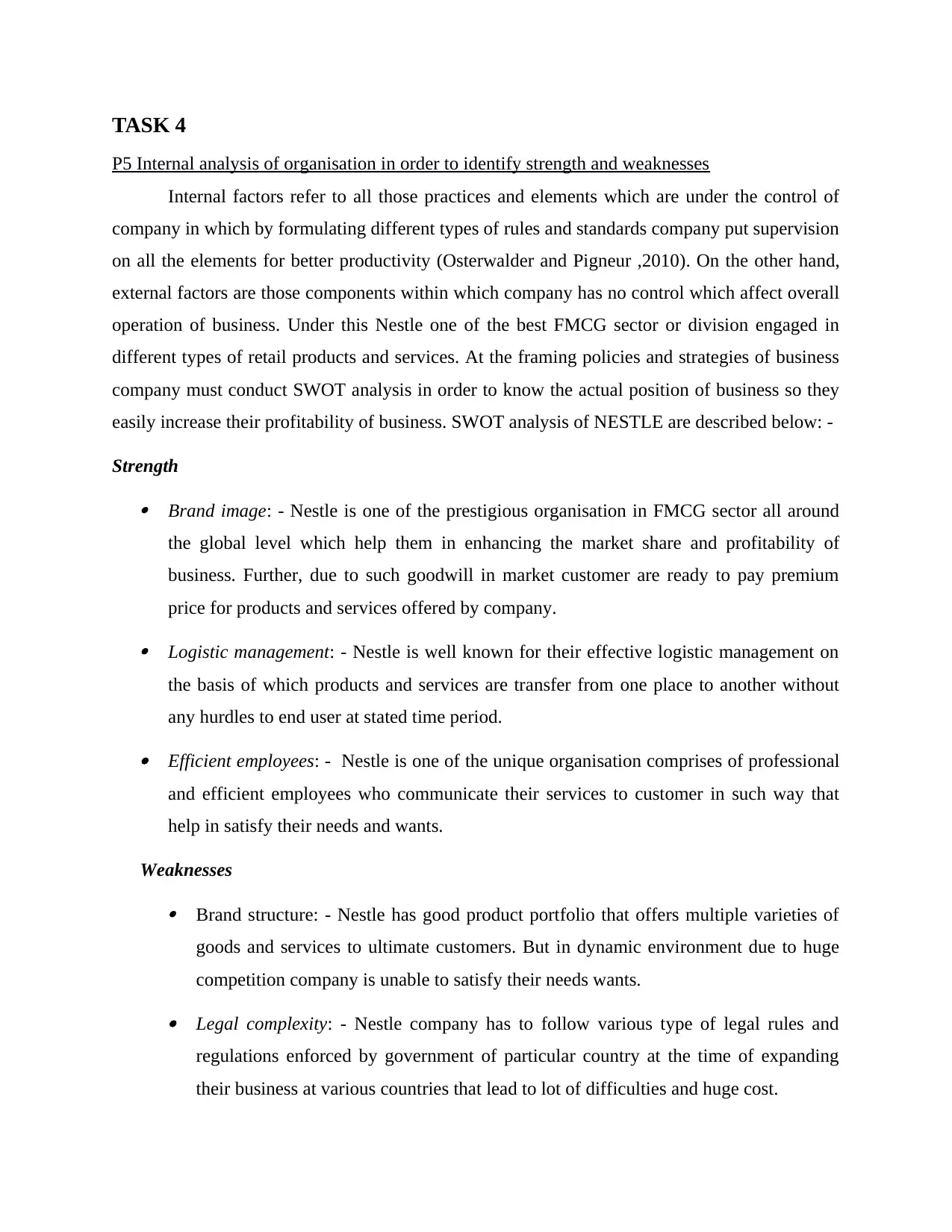
TASK 4
P5 Internal analysis of organisation in order to identify strength and weaknesses
Internal factors refer to all those practices and elements which are under the control of
company in which by formulating different types of rules and standards company put supervision
on all the elements for better productivity (Osterwalder and Pigneur ,2010). On the other hand,
external factors are those components within which company has no control which affect overall
operation of business. Under this Nestle one of the best FMCG sector or division engaged in
different types of retail products and services. At the framing policies and strategies of business
company must conduct SWOT analysis in order to know the actual position of business so they
easily increase their profitability of business. SWOT analysis of NESTLE are described below: -
Strength Brand image: - Nestle is one of the prestigious organisation in FMCG sector all around
the global level which help them in enhancing the market share and profitability of
business. Further, due to such goodwill in market customer are ready to pay premium
price for products and services offered by company. Logistic management: - Nestle is well known for their effective logistic management on
the basis of which products and services are transfer from one place to another without
any hurdles to end user at stated time period. Efficient employees: - Nestle is one of the unique organisation comprises of professional
and efficient employees who communicate their services to customer in such way that
help in satisfy their needs and wants.
Weaknesses Brand structure: - Nestle has good product portfolio that offers multiple varieties of
goods and services to ultimate customers. But in dynamic environment due to huge
competition company is unable to satisfy their needs wants. Legal complexity: - Nestle company has to follow various type of legal rules and
regulations enforced by government of particular country at the time of expanding
their business at various countries that lead to lot of difficulties and huge cost.
P5 Internal analysis of organisation in order to identify strength and weaknesses
Internal factors refer to all those practices and elements which are under the control of
company in which by formulating different types of rules and standards company put supervision
on all the elements for better productivity (Osterwalder and Pigneur ,2010). On the other hand,
external factors are those components within which company has no control which affect overall
operation of business. Under this Nestle one of the best FMCG sector or division engaged in
different types of retail products and services. At the framing policies and strategies of business
company must conduct SWOT analysis in order to know the actual position of business so they
easily increase their profitability of business. SWOT analysis of NESTLE are described below: -
Strength Brand image: - Nestle is one of the prestigious organisation in FMCG sector all around
the global level which help them in enhancing the market share and profitability of
business. Further, due to such goodwill in market customer are ready to pay premium
price for products and services offered by company. Logistic management: - Nestle is well known for their effective logistic management on
the basis of which products and services are transfer from one place to another without
any hurdles to end user at stated time period. Efficient employees: - Nestle is one of the unique organisation comprises of professional
and efficient employees who communicate their services to customer in such way that
help in satisfy their needs and wants.
Weaknesses Brand structure: - Nestle has good product portfolio that offers multiple varieties of
goods and services to ultimate customers. But in dynamic environment due to huge
competition company is unable to satisfy their needs wants. Legal complexity: - Nestle company has to follow various type of legal rules and
regulations enforced by government of particular country at the time of expanding
their business at various countries that lead to lot of difficulties and huge cost.
Paraphrase This Document
Need a fresh take? Get an instant paraphrase of this document with our AI Paraphraser
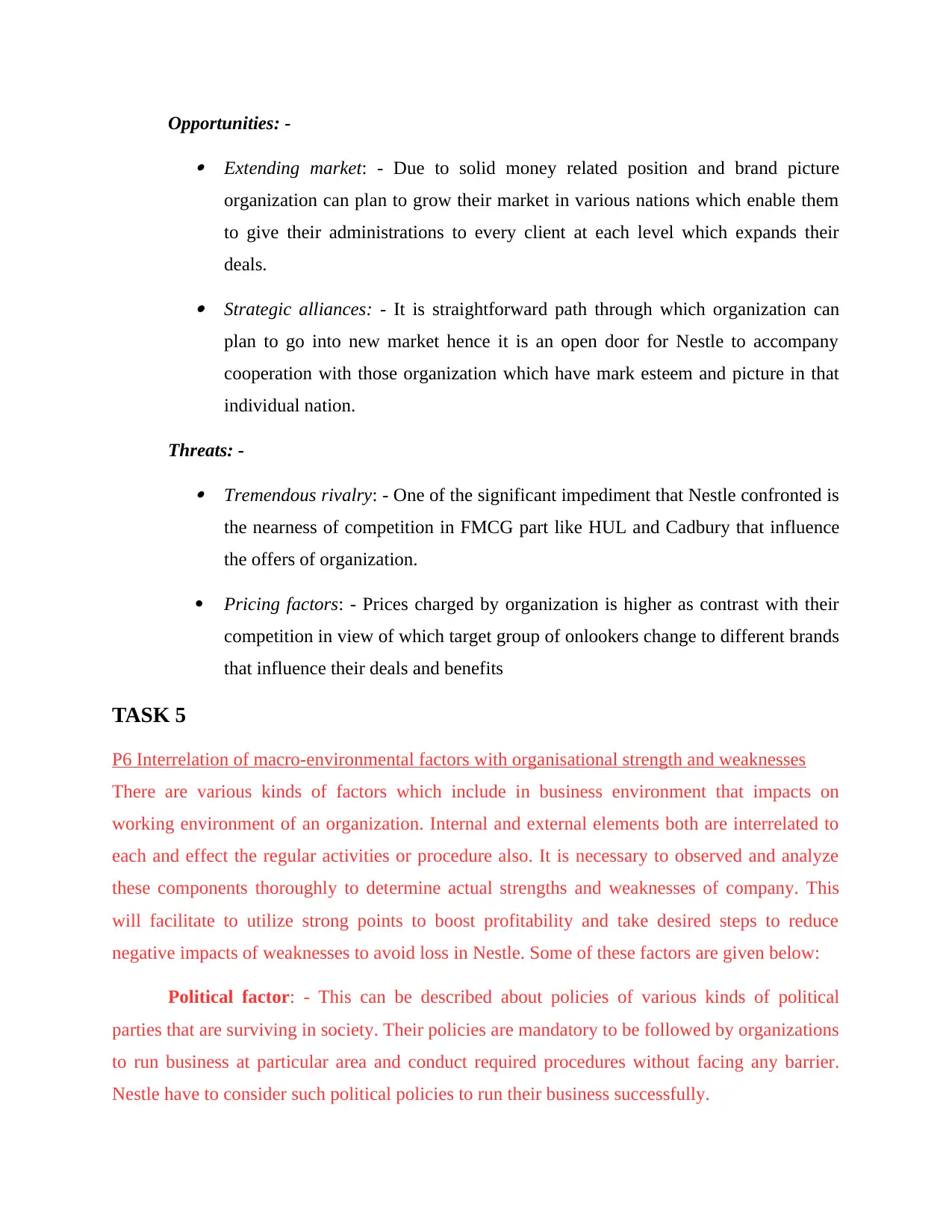
Opportunities: - Extending market: - Due to solid money related position and brand picture
organization can plan to grow their market in various nations which enable them
to give their administrations to every client at each level which expands their
deals. Strategic alliances: - It is straightforward path through which organization can
plan to go into new market hence it is an open door for Nestle to accompany
cooperation with those organization which have mark esteem and picture in that
individual nation.
Threats: - Tremendous rivalry: - One of the significant impediment that Nestle confronted is
the nearness of competition in FMCG part like HUL and Cadbury that influence
the offers of organization.
Pricing factors: - Prices charged by organization is higher as contrast with their
competition in view of which target group of onlookers change to different brands
that influence their deals and benefits
TASK 5
P6 Interrelation of macro-environmental factors with organisational strength and weaknesses
There are various kinds of factors which include in business environment that impacts on
working environment of an organization. Internal and external elements both are interrelated to
each and effect the regular activities or procedure also. It is necessary to observed and analyze
these components thoroughly to determine actual strengths and weaknesses of company. This
will facilitate to utilize strong points to boost profitability and take desired steps to reduce
negative impacts of weaknesses to avoid loss in Nestle. Some of these factors are given below:
Political factor: - This can be described about policies of various kinds of political
parties that are surviving in society. Their policies are mandatory to be followed by organizations
to run business at particular area and conduct required procedures without facing any barrier.
Nestle have to consider such political policies to run their business successfully.
organization can plan to grow their market in various nations which enable them
to give their administrations to every client at each level which expands their
deals. Strategic alliances: - It is straightforward path through which organization can
plan to go into new market hence it is an open door for Nestle to accompany
cooperation with those organization which have mark esteem and picture in that
individual nation.
Threats: - Tremendous rivalry: - One of the significant impediment that Nestle confronted is
the nearness of competition in FMCG part like HUL and Cadbury that influence
the offers of organization.
Pricing factors: - Prices charged by organization is higher as contrast with their
competition in view of which target group of onlookers change to different brands
that influence their deals and benefits
TASK 5
P6 Interrelation of macro-environmental factors with organisational strength and weaknesses
There are various kinds of factors which include in business environment that impacts on
working environment of an organization. Internal and external elements both are interrelated to
each and effect the regular activities or procedure also. It is necessary to observed and analyze
these components thoroughly to determine actual strengths and weaknesses of company. This
will facilitate to utilize strong points to boost profitability and take desired steps to reduce
negative impacts of weaknesses to avoid loss in Nestle. Some of these factors are given below:
Political factor: - This can be described about policies of various kinds of political
parties that are surviving in society. Their policies are mandatory to be followed by organizations
to run business at particular area and conduct required procedures without facing any barrier.
Nestle have to consider such political policies to run their business successfully.
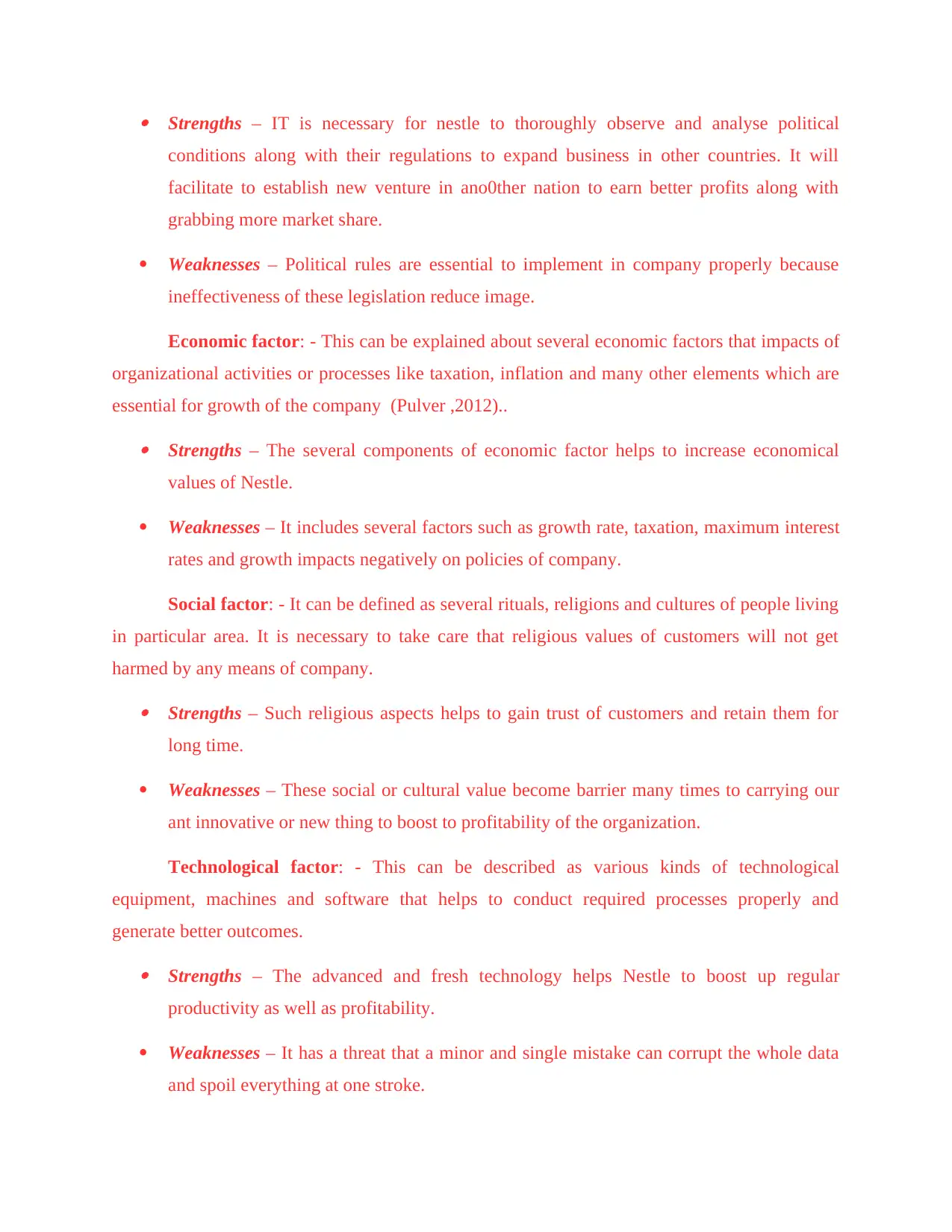
Strengths – IT is necessary for nestle to thoroughly observe and analyse political
conditions along with their regulations to expand business in other countries. It will
facilitate to establish new venture in ano0ther nation to earn better profits along with
grabbing more market share.
Weaknesses – Political rules are essential to implement in company properly because
ineffectiveness of these legislation reduce image.
Economic factor: - This can be explained about several economic factors that impacts of
organizational activities or processes like taxation, inflation and many other elements which are
essential for growth of the company (Pulver ,2012).. Strengths – The several components of economic factor helps to increase economical
values of Nestle.
Weaknesses – It includes several factors such as growth rate, taxation, maximum interest
rates and growth impacts negatively on policies of company.
Social factor: - It can be defined as several rituals, religions and cultures of people living
in particular area. It is necessary to take care that religious values of customers will not get
harmed by any means of company. Strengths – Such religious aspects helps to gain trust of customers and retain them for
long time.
Weaknesses – These social or cultural value become barrier many times to carrying our
ant innovative or new thing to boost to profitability of the organization.
Technological factor: - This can be described as various kinds of technological
equipment, machines and software that helps to conduct required processes properly and
generate better outcomes. Strengths – The advanced and fresh technology helps Nestle to boost up regular
productivity as well as profitability.
Weaknesses – It has a threat that a minor and single mistake can corrupt the whole data
and spoil everything at one stroke.
conditions along with their regulations to expand business in other countries. It will
facilitate to establish new venture in ano0ther nation to earn better profits along with
grabbing more market share.
Weaknesses – Political rules are essential to implement in company properly because
ineffectiveness of these legislation reduce image.
Economic factor: - This can be explained about several economic factors that impacts of
organizational activities or processes like taxation, inflation and many other elements which are
essential for growth of the company (Pulver ,2012).. Strengths – The several components of economic factor helps to increase economical
values of Nestle.
Weaknesses – It includes several factors such as growth rate, taxation, maximum interest
rates and growth impacts negatively on policies of company.
Social factor: - It can be defined as several rituals, religions and cultures of people living
in particular area. It is necessary to take care that religious values of customers will not get
harmed by any means of company. Strengths – Such religious aspects helps to gain trust of customers and retain them for
long time.
Weaknesses – These social or cultural value become barrier many times to carrying our
ant innovative or new thing to boost to profitability of the organization.
Technological factor: - This can be described as various kinds of technological
equipment, machines and software that helps to conduct required processes properly and
generate better outcomes. Strengths – The advanced and fresh technology helps Nestle to boost up regular
productivity as well as profitability.
Weaknesses – It has a threat that a minor and single mistake can corrupt the whole data
and spoil everything at one stroke.
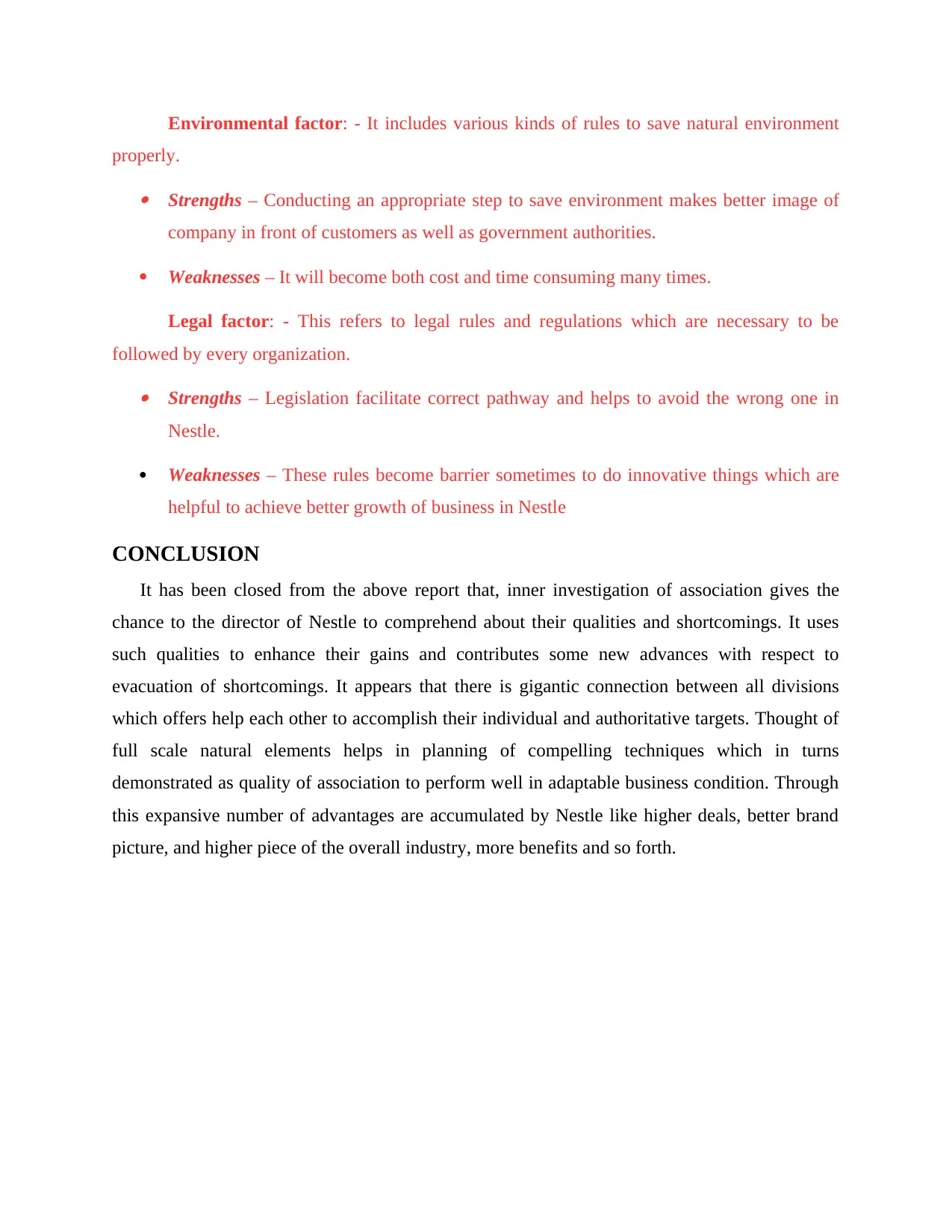
Environmental factor: - It includes various kinds of rules to save natural environment
properly. Strengths – Conducting an appropriate step to save environment makes better image of
company in front of customers as well as government authorities.
Weaknesses – It will become both cost and time consuming many times.
Legal factor: - This refers to legal rules and regulations which are necessary to be
followed by every organization. Strengths – Legislation facilitate correct pathway and helps to avoid the wrong one in
Nestle.
Weaknesses – These rules become barrier sometimes to do innovative things which are
helpful to achieve better growth of business in Nestle
CONCLUSION
It has been closed from the above report that, inner investigation of association gives the
chance to the director of Nestle to comprehend about their qualities and shortcomings. It uses
such qualities to enhance their gains and contributes some new advances with respect to
evacuation of shortcomings. It appears that there is gigantic connection between all divisions
which offers help each other to accomplish their individual and authoritative targets. Thought of
full scale natural elements helps in planning of compelling techniques which in turns
demonstrated as quality of association to perform well in adaptable business condition. Through
this expansive number of advantages are accumulated by Nestle like higher deals, better brand
picture, and higher piece of the overall industry, more benefits and so forth.
properly. Strengths – Conducting an appropriate step to save environment makes better image of
company in front of customers as well as government authorities.
Weaknesses – It will become both cost and time consuming many times.
Legal factor: - This refers to legal rules and regulations which are necessary to be
followed by every organization. Strengths – Legislation facilitate correct pathway and helps to avoid the wrong one in
Nestle.
Weaknesses – These rules become barrier sometimes to do innovative things which are
helpful to achieve better growth of business in Nestle
CONCLUSION
It has been closed from the above report that, inner investigation of association gives the
chance to the director of Nestle to comprehend about their qualities and shortcomings. It uses
such qualities to enhance their gains and contributes some new advances with respect to
evacuation of shortcomings. It appears that there is gigantic connection between all divisions
which offers help each other to accomplish their individual and authoritative targets. Thought of
full scale natural elements helps in planning of compelling techniques which in turns
demonstrated as quality of association to perform well in adaptable business condition. Through
this expansive number of advantages are accumulated by Nestle like higher deals, better brand
picture, and higher piece of the overall industry, more benefits and so forth.
Secure Best Marks with AI Grader
Need help grading? Try our AI Grader for instant feedback on your assignments.
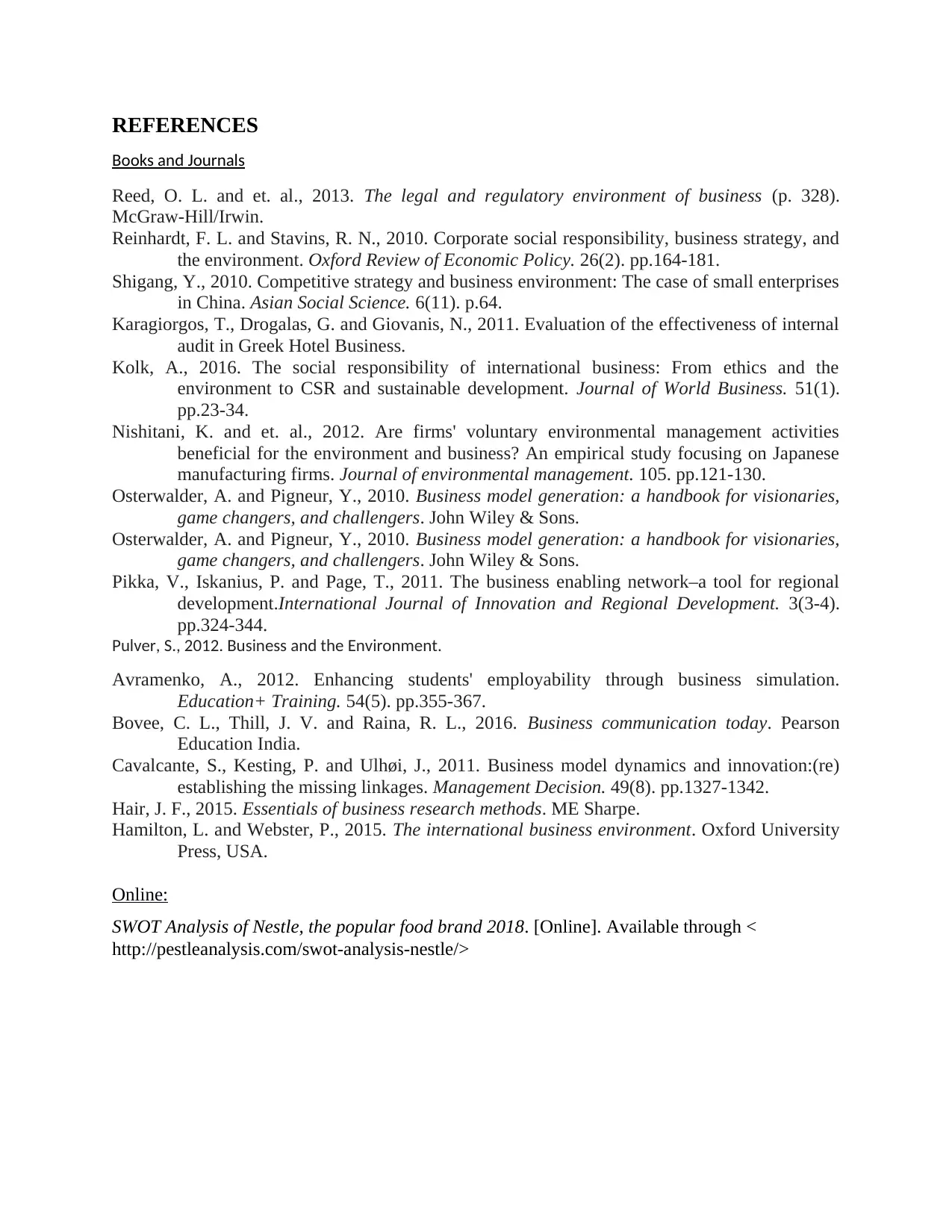
REFERENCES
Books and Journals
Reed, O. L. and et. al., 2013. The legal and regulatory environment of business (p. 328).
McGraw-Hill/Irwin.
Reinhardt, F. L. and Stavins, R. N., 2010. Corporate social responsibility, business strategy, and
the environment. Oxford Review of Economic Policy. 26(2). pp.164-181.
Shigang, Y., 2010. Competitive strategy and business environment: The case of small enterprises
in China. Asian Social Science. 6(11). p.64.
Karagiorgos, T., Drogalas, G. and Giovanis, N., 2011. Evaluation of the effectiveness of internal
audit in Greek Hotel Business.
Kolk, A., 2016. The social responsibility of international business: From ethics and the
environment to CSR and sustainable development. Journal of World Business. 51(1).
pp.23-34.
Nishitani, K. and et. al., 2012. Are firms' voluntary environmental management activities
beneficial for the environment and business? An empirical study focusing on Japanese
manufacturing firms. Journal of environmental management. 105. pp.121-130.
Osterwalder, A. and Pigneur, Y., 2010. Business model generation: a handbook for visionaries,
game changers, and challengers. John Wiley & Sons.
Osterwalder, A. and Pigneur, Y., 2010. Business model generation: a handbook for visionaries,
game changers, and challengers. John Wiley & Sons.
Pikka, V., Iskanius, P. and Page, T., 2011. The business enabling network–a tool for regional
development.International Journal of Innovation and Regional Development. 3(3-4).
pp.324-344.
Pulver, S., 2012. Business and the Environment.
Avramenko, A., 2012. Enhancing students' employability through business simulation.
Education+ Training. 54(5). pp.355-367.
Bovee, C. L., Thill, J. V. and Raina, R. L., 2016. Business communication today. Pearson
Education India.
Cavalcante, S., Kesting, P. and Ulhøi, J., 2011. Business model dynamics and innovation:(re)
establishing the missing linkages. Management Decision. 49(8). pp.1327-1342.
Hair, J. F., 2015. Essentials of business research methods. ME Sharpe.
Hamilton, L. and Webster, P., 2015. The international business environment. Oxford University
Press, USA.
Online:
SWOT Analysis of Nestle, the popular food brand 2018. [Online]. Available through <
http://pestleanalysis.com/swot-analysis-nestle/>
Books and Journals
Reed, O. L. and et. al., 2013. The legal and regulatory environment of business (p. 328).
McGraw-Hill/Irwin.
Reinhardt, F. L. and Stavins, R. N., 2010. Corporate social responsibility, business strategy, and
the environment. Oxford Review of Economic Policy. 26(2). pp.164-181.
Shigang, Y., 2010. Competitive strategy and business environment: The case of small enterprises
in China. Asian Social Science. 6(11). p.64.
Karagiorgos, T., Drogalas, G. and Giovanis, N., 2011. Evaluation of the effectiveness of internal
audit in Greek Hotel Business.
Kolk, A., 2016. The social responsibility of international business: From ethics and the
environment to CSR and sustainable development. Journal of World Business. 51(1).
pp.23-34.
Nishitani, K. and et. al., 2012. Are firms' voluntary environmental management activities
beneficial for the environment and business? An empirical study focusing on Japanese
manufacturing firms. Journal of environmental management. 105. pp.121-130.
Osterwalder, A. and Pigneur, Y., 2010. Business model generation: a handbook for visionaries,
game changers, and challengers. John Wiley & Sons.
Osterwalder, A. and Pigneur, Y., 2010. Business model generation: a handbook for visionaries,
game changers, and challengers. John Wiley & Sons.
Pikka, V., Iskanius, P. and Page, T., 2011. The business enabling network–a tool for regional
development.International Journal of Innovation and Regional Development. 3(3-4).
pp.324-344.
Pulver, S., 2012. Business and the Environment.
Avramenko, A., 2012. Enhancing students' employability through business simulation.
Education+ Training. 54(5). pp.355-367.
Bovee, C. L., Thill, J. V. and Raina, R. L., 2016. Business communication today. Pearson
Education India.
Cavalcante, S., Kesting, P. and Ulhøi, J., 2011. Business model dynamics and innovation:(re)
establishing the missing linkages. Management Decision. 49(8). pp.1327-1342.
Hair, J. F., 2015. Essentials of business research methods. ME Sharpe.
Hamilton, L. and Webster, P., 2015. The international business environment. Oxford University
Press, USA.
Online:
SWOT Analysis of Nestle, the popular food brand 2018. [Online]. Available through <
http://pestleanalysis.com/swot-analysis-nestle/>


1 out of 19
Related Documents
Your All-in-One AI-Powered Toolkit for Academic Success.
+13062052269
info@desklib.com
Available 24*7 on WhatsApp / Email
![[object Object]](/_next/static/media/star-bottom.7253800d.svg)
Unlock your academic potential
© 2024 | Zucol Services PVT LTD | All rights reserved.





